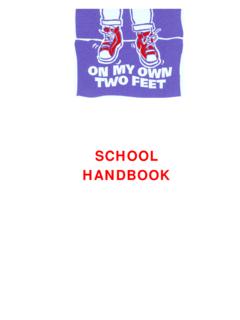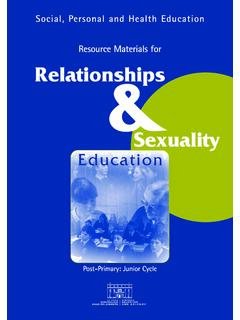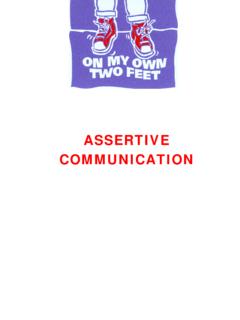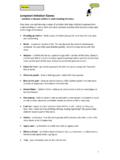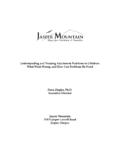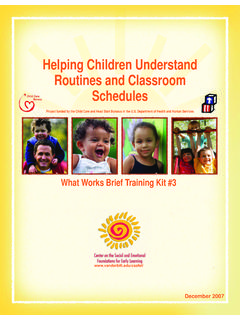Transcription of UNDERSTANDING INFLUENCES - SPHE
1 UNDERSTANDING INFLUENCES 2 UNDERSTANDING INFLUENCES This book is one of seven constituting On My Own Two Feet Educational Resource Materials for use in Substance Abuse Education Worksheets may be copied for educational purposes free and without special permission. Permission for additional use may be obtained from Dept. of Education and Science, Marlborough St., Dublin 1, Ireland An Roinn Oideachais agus Eola ochta, Department of Education and Science An Roinn Sl inte agus Leana , Department of Health and Children Mater Dei Counselling Centre ISBN No. 086387 044 9 2nd Edition 1997 3 CONTENTS INTRODUCTION 4 GRID OUTLINING MATERIALS 8 LESSON 1 WHO INFLUENCES YOU?
2 12 LESSON 2 HOW I M EXPECTED TO BE 15 LESSON 3 FRIENDSHIP 19 LESSON 4 THE WAY WE influence ONE ANOTHER 22 LESSON 5 PEER PRESSURE 24 LESSON 6 WITH FRIENDS 29 LESSON 7 WHAT A WEEKEND! 33 LESSON 8 WHY RISK IT! 36 LESSON 9 TURNING POINT! 44 LESSON 10 ADVERTISING TECHNIQUES 47 LESSON 11 ADVERTISING AND ALCOHOL 53 LESSON 12 WHAT IS A DRUG? 55 LESSON 13 WHY PEOPLE USE DRUGS 63 LESSON 14 ALCOHOL IN OUR SOCIETY 68 LESSON 15 SMOKING WHAT DO YOU KNOW? 74 LESSON 16 THE EFFECTS OF SMOKING 81 LESSON 17 SMOKING WHAT DO YOU THINK? 83 LESSON 18 THE EFFECTS OF TABLET USE 88 LESSON 19 ALCOHOL WHAT DO YOU KNOW? 92 LESSON 20 ALCOHOL WHAT DO YOU THINK?
3 994 INTRODUCTION UR DECISIONS and behaviours are influenced by internal and external factors, , our needs, our perceptions, our values, family, friends, media, community and legislation. Many of these INFLUENCES are good we get help in clarifying ideas and we learn how to do new things. Some INFLUENCES are bad, , violence in films is believed to have contributed to increased violence in society, and advertisements urge us to buy goods that we may not need. UNDERSTANDING how we are influenced helps us to make more rational decisions and to have more control in our lives. Young people need to consider how they might behave in certain situations and identify the factors that influence their behaviour.
4 They need to become more aware of, and critically examine, these INFLUENCES . PEER influence The influence of peers is especially powerful when young people are starting to feel independent. Peer conformity behaviour increases from childhood to adolescence and then declines in later adolescence. The significance of peer influence increases in importance up to age 15 16 years approximately and then begins to decrease. Existing literature highlights the importance of peer influence during the early teen years. It appears that this influence varies with the closeness of the peer relationships, with the influence of close friends being more important than the influence of the same-age peer group.
5 Most young people first use drugs, legal and illegal, with friends. Initiation into drug use appears to be a group phenomenon. Peer approval and their use of drugs rank among the most important predictors of initiation into drug use. PARENTAL influence Parents play a crucial role in the future direction which their children may take. Substance abuse education begins at the cradle, showing care for the baby and helping the development of social behaviour. There is a connection between being cared for and taking care of ourselves and others. O 5 The models the child observes are a powerful source of learning.
6 Parental drug use and attitudes exert a strong influence on young people s behaviour with regard to substance use. It is important that there is consistency in the messages young people receive and that behaviour espoused values match. influence OF MEDIA The advertising media attempt to create images of models and products to which we are meant to aspire. Generally such advertising is linked with a number of images, , fun, sexual appeal, sophistication, and adult life. Images portrayed about socially acceptable drugs medicines, tobacco and alcohol and about what constitutes mature independent behaviour need to be explored to help young people become more aware of the possible influence these images can have on their attitudes and behaviour and help them to form their own opinions.
7 CULTURAL influence Alcohol use is very widespread and is woven into many social situations in our society. It is one of the most widely used drugs. While used mainly as a social drink, it is also a widely abused drug, with very serious consequences for families and the individual who is abusing it. FACTORS IN THE INITIATION OF SUBSTANCE ABUSE Existing literature indicates that three factors are particularly important in the initiation of substance use. These are: (i) The individual s perception of social pressures and more specifically his/her perception of the extent to which significant others engage in or approve of a particular behaviour.
8 (Normative INFLUENCES ); (ii) Beliefs about consequences: perceptions of the likelihood that a behaviour will have a specific personal consequence; 6 (iii) Social bonding: individuals are less likely to smoke, drink, and use other drugs if they have a strong sense of attachment and belonging to family and school. The more this is weakened the greater the likelihood that an individual will abuse substances. SCHOOL FACTORS It is important that a school develops a clear policy with regard to use of any drugs by students and staff. This policy needs to address prevention, intervention, discipline and support. The staff need to be conscious of the messages that they are giving to students by their behaviour with regard to smoking and drinking.
9 Research has identified involvement in school (liking for and attendance) as a factor in the prevention of substance abuse. Schools, therefore, have a responsibility to create a learning environment which is responsive to the needs of students. IMPLICATIONS FOR PREVENTION It is important to help young people to explore INFLUENCES and to make up their own minds about what they want to do. It can be especially difficult to resist pressure from friends as one wants friends to like one. Helping young people to become aware of the INFLUENCES together with the development of positive self esteem and learning and practising skills to resist pressure can better equip young people to deal with the situations they encounter.
10 Teaching techniques to resist peer pressure is likely to be most effective in early adolescence when the influence of peers is strongest. The individual s beliefs about the consequences of behaviour is an important influence on behaviour, so it is essential to explore the consequences of behaviours. OVERVIEW OF THE MATERIAL IN THE SECTION The materials in this section deal with: 7 (i) UNDERSTANDING INFLUENCES in general; (ii) Recognition of and dealing with peer influence ; (iii) Recognition of and dealing with media influence ; (iv) Information on drugs in general and on smoking, tablets, alcohol and solvents specifically; (v) Exploration of attitudes to smoking and drinking and drugs in general.

